Abstract
This work presents an overview of fifth-generation (5G) technology, its key functionalities, and its applications. Then, we introduce the topic of 5G radio network planning, making analysis and design methods for coverage and capacity determinations, considering 3GPP standards. With these results, we apply the standards and procedures for a business/dense urban area in Quito city, considering the relevant parameters for calculations and simulations using the Atoll tool. Specifically, we consider the following: the key propagation models Macro/Micro, bandwidths, use cases, data rates, frequency bands (3.5/28 GHz), and modulation orders, etc. Finally, we discuss the proposed network planning and provide some useful insights regarding the 5G mobile network in Quito.
Keywords:
5G NR; radio network planning; coverage; 3GPP; capacity; link budget; simulation; atoll software 1. Introduction
In recent years, the global demand for data traffic from mobile networks and higher and faster data rates and very low latency have increased due to the high demand for various applications and the ability to connect thousands of devices simultaneously. In this fact, the fifth generation (5G) of the cellular communication system, i.e., New Radio (NR), offers these features and requirements through specific and different scenarios, such as ultra-high mobility, ultra-high connection, and ultra-high traffic [1,2,3,4,5], compared to legacy networks such as LTE [6]. Generally, radio network planning (RNP) is a critical topic and is considered to be the primary step in implementing a wireless network such as a 5G network. The services and applications provided by 5G NR networks are grouped into three use case scenarios, namely enhanced mobile broadband (eMBB), ultra-reliable and low-latency communications (uRLLC), and massive machine-type communication (mMTC), and all these use cases are applied to the Internet of Things (IoT) [7,8,9]. The level of importance of each capability in the different use cases is shown in Figure 1.
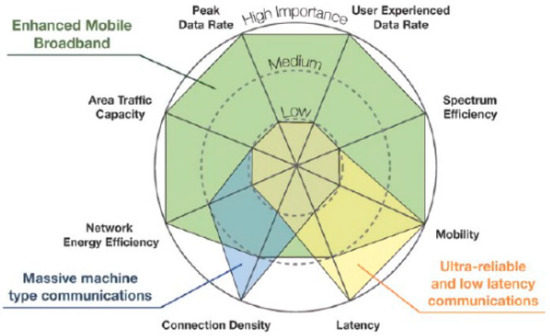
Figure 1.
Key capabilities in different use cases and scenarios [7].
The frequency bands allocated to the 5G NR network are classified into three main categories according to Table 1.

Table 1.
5G spectrum band for each scenario and use cases [7].
The main contribution of this paper is that, until now, 5G NR network planning with a C-band and millimeter wave (mm-wave) band was yet to be performed in Ecuador for the metropolitan and business areas in the north zone in Quito city [10,11,12,13]. Our goal is to show the resumed planning, designing, and evaluation of a 5G NR network in the dense urban and urban area of Quito city in Ecuador by using a C-band/mm-wave band applying a densification process using macro/micro cells in the network planning [14]. For this purpose, we use the Link budget and propagation model calculations to determine the path loss values, propagation values, and cell radius in order to calculate the number of sites required in the target zones. All these activities are applied by considering the coverage and capacity planning, dense urban/urban areas, and frequency of operation. The data calculated is tested using a planning tool called Atoll ver. 3.4.0, and our results are reflected in the simulation results from the synchronization signal—RSRP (SS-RSRP), synchronization signal to noise ratio (SS-SNR), and downlink/uplink throughput data rate plots for each scenario.
This paper is organized as follows: Section 2 defines the architecture of the 5G network, methodology, planning concepts, and employed system parameters. Section 2 also introduces 5G network planning into zones of Quito city; here, the results of the link budget and each parameter for the simulations are also presented. Section 3 presents the simulation results to verify the effectiveness of the suggested planning in Quito city, and Section 4 shows the conclusions.
2. Methodology of Research, Radio Planning, and Design of 5G Network
2.1. Methodology and General Process Flowchart for Radio Network Planning
The scheme of the research for the radio planning and design of 5G NR at the 3.5 GHz and 28 GHz frequencies for metropolitan/business areas in the north zone of Quito city is shown in Figure 2 [15]. Specifically, it presents the flowchart of the simplified basic radio planning and dimensioning from our research. This is focused on 5G NR coverage and capacity planning from the point of view that one site can serve with its resources. Coverage planning includes calculating the link budget, path losses, and throughout, as well as the attenuations and losses between the user equipment (UE) and next-generation nodeB (gnodeB) [16]. These calculations reveal the weakening signal in the wireless channel and show the maximum distances for a full-coverage radio or range from one gnodeB.
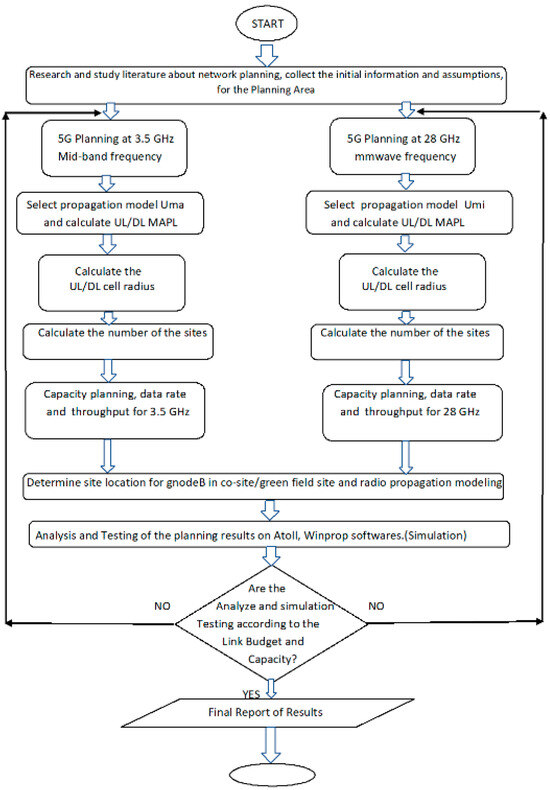
Figure 2.
Flowchart of the research for 5G NR network planning [15].
Next, we identify the path loss values using Uma/Umi propagation models recommended at 3GPP 38.901; the cell radius value is estimated as the maximum distance between gnodeB and UE. The identified cell radius value is used to calculate the site’s coverage area and determine the number of sites needed in the target zone as the final result of this coverage planning calculation [13]. With the link budget to hand, the next step is to analyze the planning results in each parameter obtained. In these terms, the initial stage of this work is to determine the locations of each site for the 5G NR network planning that can be deployed in the business/dense urban area of the north zone of Quito city. The data required in this study are about the target area, geographic location, and population in this zone of Quito. Furthermore, to calculate the services classification, data on the population density of the zone are additional requirements [16]. The next part of the planning is to calculate the data throughput and the capacity of the number of users for each site and use case. The final phase of this research is to analyze and determine the respective simulations about coverage, quality, and capacity based on the data obtained in the Link budget and design previews around the results from the calculation. The data input and necessary parameter are processed using Atoll version 3.4.0. These results are the essential part of this research, because the plots showed the coverage, quality, and capacity situations, and their parameters are compared with the coverage, quality, and data rates calculated previously throughout the Link budget [12]. The final result from the perspective of this work’s coverage is to find the number of sites needed to cover the target area location.
2.2. Link Budget Dimensioning and Planning
The maximum allowable path loss (MAPL) is the maximum attenuation received between the mobile antenna from UE and the antennas from gnodeB for uplink and downlink links throughout the air interface. The calculation of the coverage takes into account the losses between UE and gnodeB, and the required data for the calculation of the link budget, displaying the parameters used by the UE terminal and gnodeB entities, are shown in Table 2 and Table 3. First, the value of the thermal noise is calculated using (1), and the number of subcarriers is computed using (2), so [12]
where
- K = Boltzmann Constant (1.38 × 10−23 J/K)

Table 2.
Link budget simplified From 5G New Radio planning.
Table 2.
Link budget simplified From 5G New Radio planning.
| Parameters for Calculate (MAPL) | |||||
|---|---|---|---|---|---|
| Parameter | Notation | Downlink | Uplink | Downlink | Uplink |
| C-Band: 3.5 GHz | mmwave Band: 28 GHz | ||||
| gnodeB transmitter power (dBm) | a | 43 | - | 36.5 | - |
| SCS (KHz)/B (MHz) | - | 30/100 | 30/100 | 60/200 | 60/200 |
| Resource Block | RB | 273 | 273 | 264 | 264 |
| Subcarrier quantity | b | 3276 | 3276 | 3168 | 3168 |
| gnodeB antenna gain(dBi) | c | 25 | 25 | 33.5 | 33.5 |
| gnodeB cable loss (dBi) | d | 0 | 0 | 0 | 0 |
| Penetration loss (dB) | e | 28 | 28 | 19 | 19 |
| Folliage loss (dB) | f | 10 | 10 | 10 | 10 |
| Body block loss (dB) | g | 3 | 3 | 7 | 7 |
| Interference margin (dB) | h | 6 | 2 | 1 | 1 |
| Rain/Ice margin (dB) | i | 0 | 0 | 3 | 3 |
| Slow fading margin (dB) | j | 7 | 7 | 7 | 7 |
| UE antenna gain (dB) | k | 0 | 0 | 0 | 0 |
| Noise Bandwidth (SCS) (MHz) | B | 0.03 | 0.03 | 0.06 | 0.06 |
| Boltzmann Constant | K | 1.38 × 10−23 | 1.38 × 10−23 | 1.38 × 10−23 | 1.38 × 10−23 |
| Temperature (°K) | T | 293 | 293 | 293 | 293 |
| Thermal Noise Power (dBm) | l | −129.1592799 | −129.1592799 | −126.14898 | −126.14898 |
| UE noise figure (dB) | m | 9 | 9 | 9 | 9 |
| Demodulation threshold SNR (dBm) | n | −1 | −1 | −1 | −1 |
| Planning Area (Km2) | A | 6.72 | 6.72 | 6.72 | 6.72 |

Table 3.
Resource Block For medium/high-freq. band (3GPP_TS 38.101-1,38.101-2 v17.6).
Table 3.
Resource Block For medium/high-freq. band (3GPP_TS 38.101-1,38.101-2 v17.6).
| Bandwidth | SCS (KHz)—3.5 GHz | Bandwidth | SCS (KHz)—28 GHz | |||
|---|---|---|---|---|---|---|
| 15 (KHz) | 30 (KHz) | 60 (KHz) | 60 (KHz) | 120 (KHz) | ||
| 20 (MHz) | 106 | 51 | 24 | 50 (MHz) | 66 | 32 |
| 50 (MHz) | 270 | 133 | 65 | 100 (MHz) | 132 | 66 |
| 100 (MHz) | N/A | 273 | 135 | 200 (MHz) | 264 | 132 |
T = Temperature (at 293 °K),
- and,
Nthermal = Thermal Noise,
SCQ = RB × SRB
SCQ = Subcarrier quantity
RB = Resource Block
SRB = Subcarrier per Resource Block
The value of the path loss is significantly affected by the parameters used in the link budget for the planning of the 5G NR network, so the path loss is calculated using the following expression [12]:
where the required values in (3) are given in Table 2. Next, in order to obtain the value of d3D using (3), the following values need to be calculated from the 3GPP standards [14]
where hBS and hUT are the heights of the gNodeB (m) and UE (m), fc denotes the frequency of operation (GHz), c is the speed of the light, and hE = 1 m, according to (3GPP_TS_38.901).
Pathloss (dBm) = a − 10 log (b) + c − d − e − f − g − h − i − j + k − l − m − n,
h’BS = hBS − hE
h’UT = hUT − hE
d’BP = (4 × h’BS × h’UT × fc)/c,
Based on [16], the propagation model in the scenario with the Line of sight (LOS) of the Urban Macro model (Uma) and Urban Micro model (Umi), we use the following formulations, considering that 10 m < d2D < d’BP:
Lp1 = 28 + 22 log(d3D) + 20 log(fc) (Uma with LOS)
Lp2 = 32.4 + 21 log(d3D) + 20 log(fc) (Umi with LOS)
On the other hand, for the propagation model for NLOS, we use [16]:
where:
Lp3 = 13.54 + 39.08 log(d3D) + 20 log(fc) − 0.6 (hUT − 1.5) (Uma with NLOS)
Lp4 = 22.34 + 35.3 log(d3D) + 21.3 log(fc) − 0.3 (hUT − 1.5) (Umi with NLOS),
Lp1, Lp2 = Value of pathloss (dBm) for scenario LOS for Uma/Umi models
Lp3, Lp4 = Value of pathloss (dBm) for scenario NLOS for Uma/Umi models
d3D = result of the distance between and hUT (m)
d’BP = break point distance (m).
After the value of d3D (outdoor) is obtained using the Pathloss calculation of the propagation model, the value of d2D (outdoor) is the cell radius obtained from the following:
From the cell radius, the coverage area of one gnodeB site can be determined using the following expression for a three-sector model [13]:
CA = Coverage Area from gnodeB (m2) = 2.6 × (d2D)2
To determine the number of sites required in the target area of planning for coverage, this must be known for comparison with the coverage area of gnodeB. The calculation of the number of gnodeB in the case of LOS is the following [12]:
Number of site = total area surface area (Km2)/coverage area of 1 site (Km2)
where
AT = Total surface area (m2)
Cellular network planning generally covers two perspectives: coverage area planning and capacity planning [12].
2.3. Coverage Area Planning
This type of planning is radio network planning, in which calculations are based on the target zone to be covered by the gnodeB dimensioned. In fact, any parameters can influence this planning, such as the reception sensitivity from mobile devices, path loss, transmit power, link budget calculation, and cell radius. In this work, the analysis from the Link budget is used to determine the MAPL; meanwhile, the cell radius is determined using propagation models selected adequately, namely Uma and Umi. The network planning aims to determine the ideal number of sites for the business/metropolitan and dense urban areas of the north zone of Quito by calculating the coverage area for each site, considering the propagation model to be used in the simulation and the RSRP levels according to Table 4. Table 5 presents the d3D and cell radius (d2D) values using the Uma and Umi models to determine the quantity of the gnodeB needed.

Table 4.
RSRP VALUE CATEGORY [12].

Table 5.
Results of the calculations.
Here, we chose an area of about 6.72 Km2 in a dense urban/urban zone, as shown in Figure 3.

Figure 3.
Target area of business/dense area of north zone in Quito city, 5G planning.
2.3.1. 5G NR Reference Signal-Received Power (SS-RSRP)-Parameter Secondary Synchronization
SS-RSRP is the average level of the received secondary synchronization signal. This parameter compares the signal strengths of the individual cells in a 5G network; SS-RSRP is equivalent to the RSRP parameter in 4G LTE networks [9]. In gnodeB, there is a processing circuit configured to code several Synchronization Signal blocks (SSBs); each SSB is related to a different beam of a number of multiple-in-multiple-outs (MIMOs) from antennas [11]. Thus, each one of the SSBs is structured with a Primary Synchronization Signal (PSS), Secondary Synchronization signal (SSS), and Physical Broadcast Channel (PBCH).
2.3.2. 5G NR Signal-to-Noise and Interference Ratio (SS-SINR)
This parameter is the mean value of the power contribution in Watts (W) or dB of the resource elements carrying the SSS divided by the linear average of the noise and noise power contributions in W or dB, respectively. The metropolitan/business zone of the north zone in the Quito city area covered a total area of 6.72 Km2, with a percentage of 60% penetration. In the 5G network, UE measures the signal strength accepted in the SSS for the closest cell transmitter.
2.4. Capacity Planning
In this paper, capacity planning is focused on calculating the data rate and throughput. These parameters are measures that show the bits in data in the transmission process that can be sent per unit time, measured in bits per second. The maximum downlink and uplink data rates supported by the UE are calculated according to the user device’s mean category. For the design of a 5G NR network, the approximate data rate and throughput for a determined number of carriers in a bandwidth or bandwidth combination are calculated using the expressions in (14) and (15) [15], with assumptions of throughput services per use case (eMBB) and modulation order being max/min for LOS/NLOS scenarios:
where
P = Number of carrier components
Rmax = 948/1024
= Maximum number of MIMO layers
= Modulation order
= Scaling factor,
µ = Numerology
= OFDM Symbol
= Maximum number of resource blocks PRB (according to 3GPP 38.104) for selected bandwidth, frequency range, and numerology per selected carrier.
= Overhead
BW = Bandwidth.
Number of user per use case DL/UL = Data Rate (Mbps)/DL/UL Throughput service per user (Mbps).
3. Results, Analysis, and Simulations
3.1. Model Propagation Uma and Umi for 5G NR Radio Network Planning
The number of sites needed in the area planning for the business/dense urban zone of the north zone of Quito city is first calculated by selecting adequate propagation models. As mentioned in the previous section, the selected propagation models are Uma and Umi, based on the link budget formulas for 5G planning from 3GPP TS 38.901, considering a transmission antenna height of gnodeB of 25 m, a reception height from UE of 1.5 m, and an inter-site distance of 500 m [14] for a middle band and 30–100 m for a high band.
3.2. Link Budget, Coverage, and Capacity Calculation Results
In our setup, we use MIMO antennas of 64 × 64 Tx-Rx for coverage and capacity and a modulation order of 4 for the NLOS scenario and 8 for the LOS scenario. In addition, we use one carrier component, with numerology of 1 and 2 for 3.5 GHz/28 GHz, respectively. For more details about these configurations, the reader can refer to Table 5. In Table 6, we show the results of the Link Budget, coverage, and capacity planning for 3.5 GHz/28 GHz in LOS/NLOS scenarios.

Table 6.
The main system parameter [12].
3.3. Simulation Planning Results Based on Link Budget, Coverage, and Capacity Calculations
Two scenarios are used for the simulations, i.e., outdoor to outdoor (O2O) with LOS and NLOS for 3.5 GHz and 28 GHz. The new sites are allocated according to the cell radius of the coverage distance. This radio planning uses existing sites and non-existent sites. Therefore, a recommendation for new site placement per the coverage area is calculated. The site allocation is set automatically using the Automatic Coverage Planning (ACP) tool available in the Atoll software. The results of the Atoll RNP tool simulation show the number of gnodeB required to cover the target area, the values of the SS-RSRP for coverage and the SS-SINR parameters for quality, and the average throughput data rate for capacity obtained in this research, and these are shown in the following plots.
3.3.1. Scenario 1–2: O2O Downlink—SS-RSRP
In Figure 4, the average SS-RSRP obtained from the prediction using eight sites of gnodeB is −85 dBm. This means the signal strength is allocated into the mean values; meanwhile, the minimum is −110 dBm and the maximum value is −70 dBm.
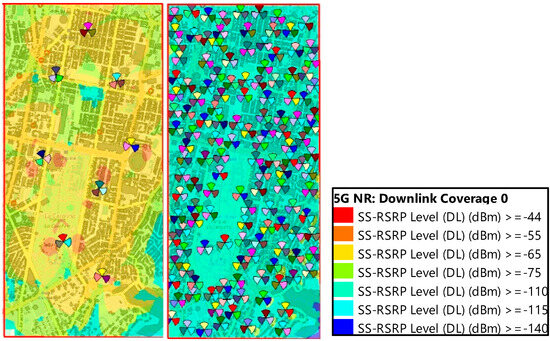
Figure 4.
SS-RSRP coverage plot with ACP: 3.5 GHz (left) and 28 GHz (right).
3.3.2. Scenario 1–2: O2O Downlink—SS-SNR
In Figure 5, the average SS-SINR obtained from the prediction using X sites of gnodeB is 17 dB. In other words, the SINR ratio is allocated into the mean values; meanwhile, this paper revealed an SS-SINR with a minimum value of −5 dB and a maximum value of 30 dB.
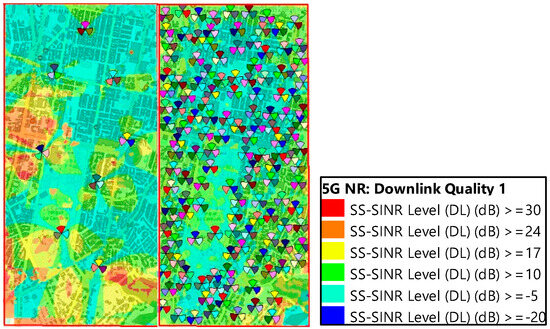
Figure 5.
SS-SINR quality plot with ACP: 3.5 GHz (left) and 28 GHz (right).
3.3.3. Scenario 1–2: O2O Downlink—Data Rate Throughput
In Figure 6, the average throughput data rate obtained from the prediction using X sites of gnodeB is 50 Mbps. Meanwhile, this research shows a throughput data rate with a minimum value of 30 Mbps and a maximum value of 100 Mbps. By comparing the above findings with those results between scenario one and scenario two, the simulation outcomes are very similar to the calculation results.
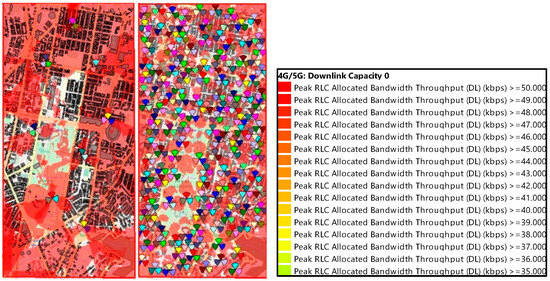
Figure 6.
DL Throughput data rate plot with ACP: 3.5 GHz (left) and 28 GHz (right).
4. Conclusions
- We have significantly contributed with a speedy and efficient way of performing the designs, calculations, and planning of 5G NR networks for business/dense urban areas in compliance with coverage, quality, and capacity objectives. In our case, this was accomplished by applying the existing 3GPP standards for 5G through the use and selection of the correct criteria, adequately applying the propagation models, urban density scenarios type, topography, LOS/NLOS criteria, service use cases, bandwidths for the user, link budget parameters, and frequency spectrum, and following best practices from commercial 5G network deployments.
- The link budget calculations and coverage, quality, and capacity simulations obtained with the Atoll tool were highly accurate and consistent with the theoretical calculations obtained. This can be verified and confirmed by the average levels achieved for the coverage SS-RSRP (>90 dBm) and quality SS-SNR (>10 dB), which ensures a good data experience, good coverage for the target area, and outstanding data throughput levels (>50 Mbps per user), with all these being observed in both planned scenarios (3.5/28 GHz).
- The results obtained from our contribution can make it easier for local mobile network operators to plan their 5G networks. This allows them to approach their designs more effectively, conducting their commercial deployments with successful commercial frequency bands in 5G networks.
Author Contributions
Conceptualization, V.F. and J.D.V.S.; methodology, J.D.V.S. and H.C.M.; software, V.F.; validation, J.D.V.S.; formal analysis, V.F. and H.C.M.; investigation, V.F. and J.D.V.S.; resources, V.F.; data curation, V.F. and J.D.V.S.; writing—original draft preparation, V.F. and J.D.V.S.; writing—review and editing, J.D.V.S. and H.C.M.; visualization, V.F; supervision, J.D.V.S.; project administration, H.C.M.; funding acquisition, V.F, J.D.V.S. and H.C.M. All authors have read and agreed to the published version of the manuscript.
Funding
This research received no external funding.
Institutional Review Board Statement
Not applicable.
Informed Consent Statement
Not applicable.
Data Availability Statement
Data are contained within the article.
Conflicts of Interest
The authors declare no conflict of interest.
References
- Shaddad, R.Q.; Al-Kmali, F.S.; Noman, M.A.; Ahmed, N.K.; Marish, E.M.; Al-Duais, A.M.; Al-Yafrsi, A.A.; Al-Sabri, F.A. Planning of 5G Millimeterwave Wireless Access Network for Dense Urban Area. In Proceedings of the 2019 First International Conference of Intelligent Computing and Engineering (ICOICE), Hadhramout, Yemen, 15–16 December 2019; pp. 1–4. [Google Scholar] [CrossRef]
- Shah SA, W.; Khattab, T.; Shakir, M.Z.; Hasna, M.O. A distributed approach for networked flying platform association with small cells in 5G+ networks. In Proceedings of the GLOBECOM 2017—2017 IEEE Global Communications Conference, Singapore, 4–8 December 2017. [Google Scholar]
- Chen, Z.; Lee, J.; Quek, T.Q.; Kountouris, M. Cooperative caching and transmission design in cluster-centric small cell networks. IEEE Trans. Wirel. Commun. 2017, 16, 3401–3415. [Google Scholar] [CrossRef]
- Fallgren, M.; Timus, B. Scenarios Requirements and KPIs for 5G Mobile and Wireless System. Available online: https://cordis.europa.eu/docs/projects/cnect/9/317669/080/deliverables/001-METISD11v1pdf.pdf (accessed on 7 August 2023).
- Jamalzadeh, M.; Ong, L.-D.; Mohd, M.N.B. 5GTechnologies: A New Network Architectures and Design. J. Internet Technol. 2018, 19, 1983–1991. [Google Scholar]
- Sukarno, A.; Hikmaturokhman, A.; Rachmawaty, D. Comparison of 5G NR Planning in Mid-Band and High-Band in Jababeka Industrial Estate. In Proceedings of the 2020 IEEE International Conference on Communication, Networks and Satellite (Comnetsat), Batam, Indonesia, 17–18 December 2020; pp. 12–17. [Google Scholar] [CrossRef]
- Situmorang, A.C.; Gunawan, D.; Anggraini, V.G. 5G Trials on 28 GHz Band in Indonesia. In Proceedings of the 28th Wireless and Optical Communication Conference (WOCC 2019), Beijing, China, 9–10 May 2019. [Google Scholar]
- Al-Mekhlafi, A.A.; Al-Kamali, O.M.; Shaddad, R.Q.; Abduljalil, M.A. Dense 5G Network Planning for Coastal Area at Aden City, Yemen. In Proceedings of the 2019 First International Conference of Intelligent Computing and Engineering (ICOICE), Hadhramout, Yemen, 15–16 December 2019; pp. 1–7. [Google Scholar] [CrossRef]
- Rianti, D.; Hikmaturokhman, A.; Rachmawaty, D. Techno-Economic 5G New Radio Planning Using 26 GHz Frequency at Pulogadung Industrial Area. In Proceedings of the 2020 3rd International Seminar on Research of Information Technology and Intelligent Systems (ISRITI), Yogyakarta, Indonesia, 10 December 2020; pp. 272–277. [Google Scholar] [CrossRef]
- Ekawibowo, S.A.; Pamungkas, M.P.; Hakimi, R. Analysis of 5G Band Candidates for Initial Deployment in Indonesia. In Proceedings of the 2018 4th International Conference on Wireless and Telematics (ICWT), Nusa Dua, Bali, 12–13 July 2018; pp. 1–6. [Google Scholar]
- Fahira, G.; Hikmaturokhman, A.; Danisya, A.R. 5G NR Planning at mmWave Frequency: Study Case in Indonesia Industrial Area. In Proceedings of the 2020 2nd International Conference on Industrial Electrical and Electronics (ICIEE), Lombok, Indonesia, 10–11 June 2020; pp. 205–210. [Google Scholar] [CrossRef]
- Esa, R.N.; Hikmaturokhman, A.; Danisya, A.R. 5G NR Planning at Frequency 3.5 GHz: Study Case in Indonesia Industrial Area. In Proceedings of the 2020 2nd International Conference on Industrial Electrical and Electronics (ICIEE), Lombok, Indonesia, 10–11 June 2020; pp. 187–193. [Google Scholar] [CrossRef]
- Karo, F.K.; Hikmaturokhman, A.; Amanaf, M.A. 5G New Radio (NR) Network Planning at Frequency of 2.6 GHz in Golden Triangle of Jakarta. In Proceedings of the 2020 3rd International Seminar on Research of Information Technology and Intelligent Systems (ISRITI), Yogyakarta, Indonesia, 10 December 2020; pp. 278–283. [Google Scholar] [CrossRef]
- Huawei. 5G Link Budget ‘Best Partner for Innovation. Available online: https://telecomfiles.com/5g-link-budget (accessed on 1 August 2023).
- 3GPP, 5G. Study on Channel Model for Frequencies from 0.5 to 100 GHz (3GPP TR 38.901 version 14.0.0 Release 14). ETSI TR138.901; 3GPP: Valbonne, France, 2017. [Google Scholar]
- 3GPP, 3rd Generation Partnership Project. In Technical Specification Group Radio Access Network. NR. User Equipment (UE) Radio Access Capabilities; 3GPP: Valbonne, France, 2019.
Disclaimer/Publisher’s Note: The statements, opinions and data contained in all publications are solely those of the individual author(s) and contributor(s) and not of MDPI and/or the editor(s). MDPI and/or the editor(s) disclaim responsibility for any injury to people or property resulting from any ideas, methods, instructions or products referred to in the content. |
© 2023 by the authors. Licensee MDPI, Basel, Switzerland. This article is an open access article distributed under the terms and conditions of the Creative Commons Attribution (CC BY) license (https://creativecommons.org/licenses/by/4.0/).